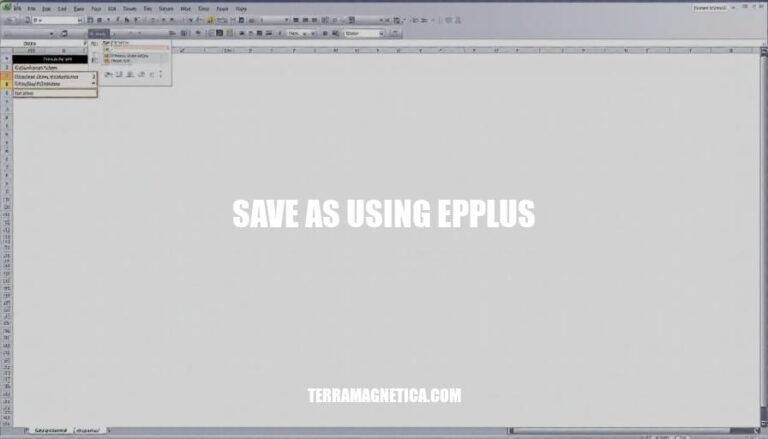


EPPlus is a powerful .NET library that allows developers to create, read, and modify Excel files programmatically. The “Save As” feature in EPPlus is crucial because it enables saving changes to a new file, preserving the original data. This is particularly important for tasks like generating reports, data analysis, and automating workflows without manual intervention.
Here’s a concise guide to get you started with EPPlus for saving files:
Install EPPlus via NuGet:
Install-Package EPPlus
Basic Configuration:
using OfficeOpenXml;
using (var package = new ExcelPackage())
{
var worksheet = package.Workbook.Worksheets.Add("Sheet1");
worksheet.Cells[1, 1].Value = "Hello, EPPlus!";
package.SaveAs(new FileInfo(@"C:\path\to\your\file.xlsx"));
}
That’s it! You’ve installed EPPlus and created a basic Excel file.
To create an Excel package in C, you can use the libxlsxwriter library. Here are the steps:
Install libxlsxwriter:
Include the library in your project:
#include "xlsxwriter.h"
Create a new workbook and add a worksheet:
lxw_workbook *workbook = workbook_new("demo.xlsx");
lxw_worksheet *worksheet = workbook_add_worksheet(workbook, NULL);
Write data to the worksheet:
worksheet_write_string(worksheet, 0, 0, "Hello", NULL);
worksheet_write_number(worksheet, 1, 0, 123, NULL);
Close the workbook:
workbook_close(workbook);
Here’s a complete example:
#include "xlsxwriter.h"
int main() {
lxw_workbook *workbook = workbook_new("demo.xlsx");
lxw_worksheet *worksheet = workbook_add_worksheet(workbook, NULL);
worksheet_write_string(worksheet, 0, 0, "Hello", NULL);
worksheet_write_number(worksheet, 1, 0, 123, NULL);
workbook_close(workbook);
return 0;
}
This will create an Excel file named demo.xlsx with some sample data.
To use the SaveAs method in EPPlus to save an Excel file, follow these steps:
Create an Excel package:
using OfficeOpenXml;
using System.IO;
var file = new FileInfo(@"C:\path\to\your\file.xlsx");
using (var package = new ExcelPackage(file))
{
// Add a worksheet
var worksheet = package.Workbook.Worksheets.Add("Sheet1");
// Add some data
worksheet.Cells[1, 1].Value = "Hello, EPPlus!";
// Save the file
package.SaveAs(file);
}
Save to a different location:
using OfficeOpenXml;
using System.IO;
var originalFile = new FileInfo(@"C:\path\to\your\originalFile.xlsx");
var newFile = new FileInfo(@"C:\path\to\your\newFile.xlsx");
using (var package = new ExcelPackage(originalFile))
{
// Add a worksheet
var worksheet = package.Workbook.Worksheets.Add("Sheet1");
// Add some data
worksheet.Cells[1, 1].Value = "Hello, EPPlus!";
// Save the file to a new location
package.SaveAs(newFile);
}
This code demonstrates how to create an Excel file, add a worksheet, insert data, and save the file using the SaveAs method in EPPlus.
Here are some best practices for handling file paths when using ‘Save As’ with EPPlus:
Use Absolute Paths: Always use absolute paths to avoid issues with relative paths, especially when your application might be run from different directories.
Validate Paths: Ensure the file path is valid and accessible. Check for invalid characters and ensure the directory exists before attempting to save.
Handle Exceptions: Implement proper exception handling to manage scenarios where the file path might be invalid or inaccessible due to permissions or other issues.
File Overwrite: Decide whether to overwrite existing files or not. If overwriting, ensure you handle the logic to delete or backup the existing file.
Security Considerations: Avoid hardcoding file paths. Use configuration files or environment variables to manage paths securely.
Cross-Platform Compatibility: Ensure your file paths are compatible with different operating systems if your application is cross-platform.
Path Normalization: Normalize paths to handle different path separators (e.g., / vs. \) to ensure consistency across different environments.
Use Path.Combine: Utilize Path.Combine to construct file paths safely, avoiding issues with manual concatenation.
Example:
string directory = @"C:\MyDirectory";
string fileName = "MyExcelFile.xlsx";
string fullPath = Path.Combine(directory, fileName);
using (ExcelPackage package = new ExcelPackage())
{
// Add your Excel data here
// Save the file
package.SaveAs(new FileInfo(fullPath));
}
These practices help ensure your file operations are robust and error-free.
Sure, here are some strategies for error handling and debugging when implementing ‘Save As’ using EPPlus:
Try-Catch Blocks:
Validation:
Using FileInfo:
FileInfo to check if the file exists and has the correct permissions.EPPlus Settings:
ExcelPackage.LicenseContext.Debugging Tools:
Unit Tests:
Resource Management:
ExcelPackage objects to free resources.Error Logging:
When using EPPlus to save an Excel file, it’s essential to handle file paths carefully to avoid issues with relative paths, invalid characters, and inaccessible directories.
Always use absolute paths, validate them before saving, and implement proper exception handling to manage scenarios where the file path might be invalid or inaccessible due to permissions or other issues.
Path.Combine to construct file paths safely, avoiding issues with manual concatenation.When implementing ‘Save As’ logic:
FileInfo to check if the file exists and has the correct permissions.EPPlus settings can be configured to throw exceptions for invalid operations using ExcelPackage.LicenseContext.
Debugging tools like breakpoints and watches can help inspect variables and flow, while unit tests cover different scenarios, including edge cases.
Proper disposal of ExcelPackage objects is crucial to free resources, and implementing logging captures and analyzes errors.
By following these best practices and strategies, developers can ensure their ‘Save As’ operations using EPPlus are robust, error-free, and efficient.